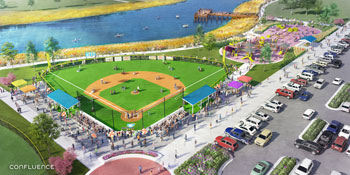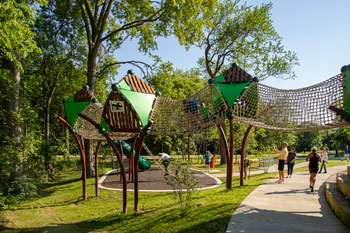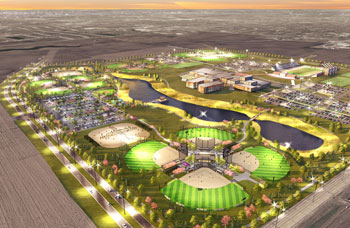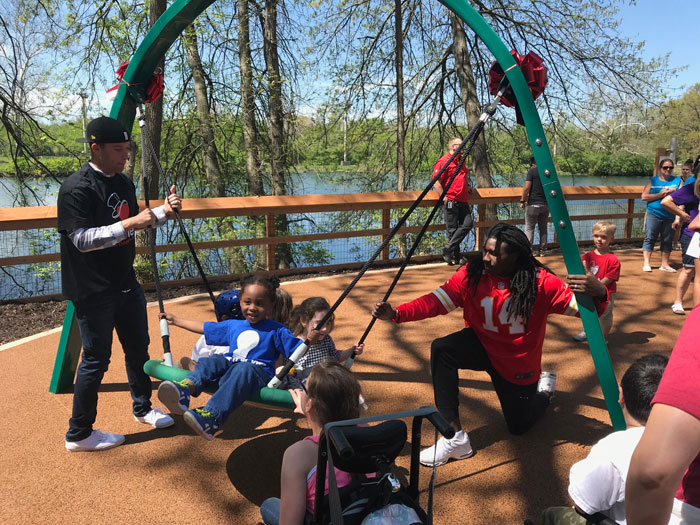By PJ Novick and Matt Carlile
Imagine growing up thinking that playgrounds just aren’t made for you. For children of varying abilities, those with motor or sensory challenges, that perception is not uncommon.
Thirty years ago, “inclusive design” meant adding a ramp, or perhaps a play element that could accommodate a wheelchair. But chances are, that play element wasn’t part of the main play structure. As a result, children who used it were unable to participate in a meaningful way in play with their peers, missing out on valuable social interaction and experiences. While the park features designed to accommodate mobility challenges at that time were scant, even today you’d be hard pressed to find a playground designed to meet the needs of children with less visible challenges, such as those on the autism spectrum.
As landscape architects, there is so much more we can to do create inclusive parks, starting with expanding our understanding of the different needs of children and their caregivers, and taking a more thoughtful approach to the planning process with the goal of creating spaces that are exciting, challenging and fun for everyone to use, regardless of ability.
Understanding Your Audience

When approaching a park’s design, it’s important to reframe the priority from creating elements that are merely accessible to creating a holistic design that is truly inclusive. Rather than a park that offers a variety of fun experiences for certain kids, the design should be flexible enough that virtually all of the elements are capable of providing rewarding experiences for all children.
The best way to understand what a rewarding experience would look like for differently abled children and their caregivers is to engage directly with the source. For Triumph Park in Waukee, Iowa, our goal was to create a regional destination for young athletes throughout the state of Iowa, while equally including recreational amenities for community members of all abilities. We worked closely with the City of Waukee Parks and Recreation Department and Landscape Structures to create one of the largest all-inclusive playgrounds in the nation, an ADA-accessible dynamic fishing pier and an all-inclusive Miracle Field to host a Miracle League for the community of Waukee.
The Miracle League is an organization that provides opportunities for children with disabilities to play Miracle League baseball, no matter their ability level. They provided our design team with a highly detailed set of guidelines that described the specific dimensions of the park. These guidelines were then used to shape design decisions for the other sports fields—as it was essential to us that the Miracle Field looked and felt like the rest of the fields in the athletic complex.
When it came time to design a new playground within the Kansas City Zoo to offer engaging experiences for children of all abilities, Confluence worked with Variety Kansas City (Variety KC), an organization that advocates for the inclusiveness of children with disabilities within the Kansas City community, and with Friends of the Zoo Inc., the operator of the Kansas City Zoo, to better understand the typical park-going experience for their children.
Through this process, we learned about challenges on a typical playground, not only in terms of access, but parity of experience. Children wished they could play alongside their peers more often.

These conversations helped inform a design that includes a zip line that allows paraplegic children to move right alongside their friends, providing both a fun and—importantly—an equitable experience. Special solid surfacing supports motorized wheelchair operation throughout the grounds, allowing these children to access all playground elements—something that is a major challenge in most other parks. The design also features an “elephant swing” that offers a large base that is accessible and comfortable for children of all abilities. The swing can also accommodate multiple children at once, encouraging interaction and engagement and providing parity in the experience.
At Triumph Park, we also prioritized providing an experientially inclusive experience. Many times, the appearance of Miracle Fields are different than typical ball fields and become isolated destinations. Triumph Park puts these features in the heart of the athletic complex. All children, regardless of ability, have the opportunity to watch one another’s games, mingle and hang out between games.
Providing Appropriate Levels of Challenge
The concept of parity is vitally important in offering an inclusive experience. The design of the park and the play elements should offer challenges appropriate for all skill levels and all mobility ranges. Just because they may require certain mobility tools doesn’t mean that a child wants to take the easiest route every time. And children who don’t have specific mobility needs are easily given the chance to explore their balance, dexterity and bravery on elements such as climbing walls, draw bridges and tall slides.
At Wilder Bluff Park in Shawnee, Kan., for example, Confluence designed a playground structure that allows paraplegic children to move right alongside their friends high above the ground between elevated treehouse structures and platforms.
The inventive design for this park includes mobility ramps that don’t look like your typical wheelchair ramp—they are intentionally integrated into the site design. In some cases, like the entrance to the tree walk-up, there’s only one route providing access to the play space, so children who use a wheelchair enjoy the same experience as their friends.
Addressing the Full Range of Abilities

As we work to design spaces that are more inclusive for everyone, it’s important to acknowledge that what makes a typical park difficult for a child may not be mobility-related at all. In addition to supporting the experience for children who may need more obvious assistance from wheelchairs, walkers, crutches or AFOs, a good park design must also consider the needs of children with deafness, blindness, Autism Spectrum Disorder developmental issues, and sensory integration challenges.
Park-goers with certain behavioral traits may have a tendency to bolt at a moment’s notice if triggered or over-stimulated. Caregivers may therefore appreciate a playground design that features an enclosure—either through landscaping or physical structures. Playing in an enclosed space allows everyone to relax knowing that no one is going to run into a busy street or otherwise present a safety risk.
Including spaces for passive play, like an area that is closer to trees and natural shade, can also create a more relaxing environment for children with sensory issues. These areas should be visually connected to the rest of the park, but allow a natural noise buffer to create a quieter area. An area for low-sensory play is included at the Kansas City Zoo Park near a natural water overlook. The space is clearly identified as a quiet zone, allowing children to use the park however they feel comfortable without feeling left out. At this park, there are also sensory kits available for checkout that include items like noise canceling headphones that can make a noisy park experience more enjoyable.
Considering the Full Park Experience
An inclusive park doesn’t begin with the playground equipment, of course, so it’s important to consider ways to create parity across the entire park-going journey—including convenient and accessible parking, walking paths, site features and park amenity facilities (e.g., restrooms, bandshells, picnic areas). Less commonly considered aspects in park design include locating parking facilities and trail connections to effectively integrate sloping site conditions and accessibility needs, which can all make a park experience easier and more enjoyable. Intuitively experiencing a well-planned public space where these considerations have been integrated can relieve a tremendous amount of stress on children and their caregivers.
Ultimately, by creating an experience that allows children of all abilities to play side-by-side, our parks can help foster more open-minded and empathetic interactions—between both children and adults. The biggest takeaway here is that creating these types of welcoming and inviting park facilities typically doesn’t require significant additional capital investment if integrated into the design process at the outset. What is needed is a more creative and thoughtful approach to design and an engagement process that brings a greater diversity of voices to the table. RM



